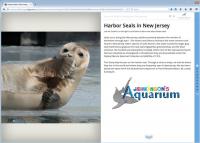Atlantic Loggerhead Turtle
The Atlantic loggerhead turtle (Caretta caretta) is recognized across the globe as an endangered species. Loggerhead populations are currently a tiny fraction of their historic size.
The loggerhead turtle (Caretta caretta) is recognized across the globe as an endangered species. The federal government classifies it as threatened across its range in the U.S., while in New Jersey, the loggerhead is considered endangered. Loggerhead populations are currently a tiny fraction of their historical size.
The loggerhead turtle is a large reddish-brown sea turtle with a relatively large head that gives it its name. Adult loggerheads range in size from 33 to 49 inches in shell length and can weigh over 400 pounds. Its limbs, as with all sea turtles, are flattened flippers. The shells of loggerhead turtles are often covered with plants and small animals that hitch a free ride through the oceans.
Loggerheads occupy various coastal habitats from bays and estuaries to the clear waters of reefs.
Loggerhead turtles occur within the warmer portions of the Atlantic, Indian, and Pacific oceans. In the Atlantic Ocean, they feed from Brazil to Canada. In New Jersey, they have been seen in the Atlantic Ocean as well as in the Barnegat, Delaware, and Raritan bays, usually between the months of May through November.
Loggerheads occupy various coastal habitats from bays and estuaries to the clear waters of reefs. They are frequently seen around wrecks where food is plentiful. Their large heads contain powerful crushing jaws with which they feed on crabs and other shellfish. Adults forage on the ocean floor and can dive over 700 feet deep, remaining under water for up to an hour at a time. They also forage on the surface for jellyfish. Young loggerheads feed primarily on prey concentrated at the surface.
Like all sea turtles, loggerheads lay eggs on land. After mating offshore, they return to the same area for each nesting to lay clutches of eggs on open sandy beaches above the high tide mark. Along the U.S. Atlantic Coast, the major nesting areas range from Florida to North Carolina, although nesting has been documented as far north as New Jersey with one nesting record from Island Beach State Park. Loggerheads migrate thousands of miles between nesting beaches and feeding grounds.
 Off-shore waters of New Jersey are considered to be great habitat for loggerheads. © Bill Dalton
Off-shore waters of New Jersey are considered to be great habitat for loggerheads. © Bill Dalton
Female loggerheads become sexually mature between 15 and 30 years. They are reproductively active for about 30 years, but only nest every 2-3 years. They lay between 100 and 120 eggs per clutch. If a clutch of eggs is laid during a period of warmer temperatures, a higher number of females will hatch, and if laid during cooler periods, a higher number of males will emerge.
Out of every thousand hatchlings, only a few will survive to adulthood. Hatchlings emerge from the nest a few days after hatching, typically during darkness. Once they reach water, males never return to shore, while females only do so to nest. The hatchlings, which are less than 2 inches in size, often float in masses of sea plants (sargassum) for their first 3-5 years. From hatchling to adulthood, a loggerhead increases its weight more than 6,000 times.
Oil spills, habitat degradation (such as beach development) and collisions with boats present other dangers to the turtles.
Loggerhead turtle populations have declined worldwide due to overharvesting of eggs for food, killing of adults and loss of nesting habitat. Entanglement in fishing nets or marine debris and the ingestion of marine debris represent the most serious threats to their existence and recovery.
Oil spills, habitat degradation (such as beach development) and collisions with boats present other dangers to the turtles. Eggs can be destroyed by predators, beach erosion, off-road vehicles and flooding by seawater or excessive rainfall. Beach cleaning operations can destroy nests or produce tire ruts that stop hatchlings from moving to the sea. Beachfront lighting can cause hatchlings to become disoriented and fail to reach the water.
Global warming will also have an impact on these turtles. Sea level rise when coupled with shoreline development may reduce available nesting beaches. Warmer temperatures during incubation will produce more female hatchlings and may cause an imbalance in the sex ratio.
In New Jersey, no-wake zones in our bays and estuaries help minimize the risk of boat strikes to loggerhead turtles in our waters. Designated marine conservation zones provide safe habitat for the loggerhead to forage. Protection of nesting sites along the East Coast is critical to the future of the loggerhead and other marine turtles in our waters.
written by Michael Davenport
Find Related Info: Reptiles, Endangered





